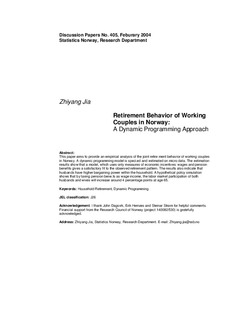| dc.contributor.author | Jia, Zhiyang | |
| dc.date.accessioned | 2011-11-22T18:13:51Z | |
| dc.date.available | 2011-11-22T18:13:51Z | |
| dc.date.issued | 2005 | |
| dc.identifier.issn | 1892-753x | |
| dc.identifier.uri | http://hdl.handle.net/11250/180285 | |
| dc.description.abstract | Abstract:
This paper aims to provide an empirical analysis of the joint retirement behavior of working couples
in Norway. A dynamic programming model is specified and estimated on micro data. The estimation
results show that a model, which uses only measures of economic incentives: wages and pension
benefits gives a satisfactory fit to the observed retirement pattern. The results also indicate that
husbands have higher bargaining power within the household. A hypothetical policy simulation
shows that by taxing pension benefits as wage income, the labor market participation of both
husbands and wives will increase around 4 percentage points at age 65. | no_NO |
| dc.language.iso | eng | no_NO |
| dc.publisher | Statistics Norway, Research Department | no_NO |
| dc.relation.ispartofseries | Discussion Papers;No. 405 | |
| dc.subject | Household retirement | no_NO |
| dc.subject | Retirement | no_NO |
| dc.subject | Working couples | no_NO |
| dc.subject | Norway | no_NO |
| dc.subject | JEL classification: J26 | no_NO |
| dc.subject | Dynamic programming model | no_NO |
| dc.title | Retirement behavior of working couples in Norway. A dynamic programming approach | no_NO |
| dc.type | Working paper | no_NO |
| dc.subject.nsi | VDP::Social science: 200::Economics: 210::Economics: 212 | no_NO |
| dc.source.pagenumber | 31 s. | no_NO |
